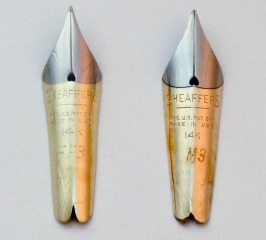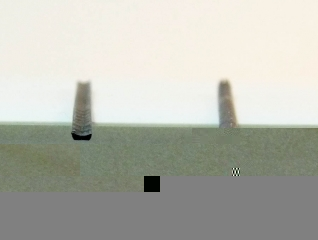Last post I showed you a few Sheaffer Snorkels with flexible nibs. While I was doing that I took a closer look at them and found a few interesting tidbits which in my pen filled brain were fascinating. If you are as occupied with esoterica as I am you might find it interesting too, but first a little story:
I’ve repaired and built a number of Snorkels usually with good results. However, one I made (the original Frankensnork) wound up with a bit of a problem: ink starvation. That pen had a flexible stub nib and while all seemed well enough I soon was made aware that sometimes (while being exercised by its owner who is well known for the ability stretch pens to their limits) the line being drawn would peter out. Not enough ink flowing to the point during grueling calligraphic maneuvers was the root cause. Of course I felt rather inept at not noticing this when I tested the pen originally and felt I must have overlooked something. My contrition is legendary and all I could do was swear at myself a lot and wonder.
So why did a perfectly fine, to all appearances, Snorkel so act? That old question was on my mind as I disassembled and examined my newest flex Snork. Imagine my surprise to find that Sheaffers with the flexible nibs had differently constructed feeds! Imagine my surprise that I was too thick to have noticed this before!
In case you don’t know about feeds they are what supply ink from the reservoir to the writing point. The basic function of this piece, usually made out of hard rubber, is to allow ink to flow to the business end via a channel and also contain excess fluid in a ridged part called a comb. This link goes to a good in-depth explanation of how this all works. A delicate balance is maintained by a feed so it can supply enough ink for writing while allow air to pass the opposite way to replace what is drained. If either one of these is slacking in its work you get that starvation I mentioned.
It seems that Sheaffer combated this in the high flow flexible nib Snorkels by creating a super feed that could really move the ink. This brings us to a quick sketch of the complex inner mechanism of a Snorkel, I’m afraid. Hold on through this boring part and you get to see the pretty pictures (well, if you like boring pen bits they are pretty). A Snorkel has a tube that can be extended outwards from under the nib when the knob at the other end of the pen is twisted. An extensive advertising campaign explained this action to be a wonderful boon to mankind in that the pen did not have to be dunked into the ink for filling but only the end of the tube. Yep, no wiping off of the nib when you need to top up the writing fluid. Not quite the same importance as polio vaccine but this was the 50s when automotive tail fins were considered a triumph. I’m not going to go to much farther into how this all works (but here’s a good link to that here) except to say that not only is the ribbed feed under the nib part of the ink delivery unit but so is the tube. Thus, the tube has a thin strip of hard rubber that acts like a feed extension which passes the ink baton to the external one. So, specifically what did Sheaffer do to increase ink flow? Simple, they made the pipes bigger. By that I mean the spots ink flow through were increased in size (quite a bit) so the nib would keep spitting out ink even if the user was ham handed and flexed the heck out of every character they wrote. Let’s take a look in pictures, shall we? Don’t forget to click on them to see them large.
First is a comparison of a flex and non-flex open, two-tone style #3 nib. You’ll see that they look similar enough but upon close inspection the flex nib (with the code FF3 on it) doesn’t have the impressed line that mark the boundary between the silver and the gold sections as the less acrobatic firm medium one. Since the flex nib is thinner (and possibly metallurgically different) I’d wager removal of this embossing was to prevent a weak area that could snap or crack in use. It could have acted like paper when scored to form a crease to ease folding. A bent or broken nib is not something you’d be very happy about while writing a letter. The platinum mask (a thin plating, really) on the flexible nib is applied to mimic the one with the grooves in it. I always like to think there was a back room at the Sheaffer nib works were a few folks labored over these not widely produced nibs with loving care. Yes, overly romantic indeed.
Next let’s look at the feeds that live down below. The picture is of the top of them which comes into contact with the underside of the nibs. You’ll see the one that services our flexible friends has a wider groove down the middle. This is an ink supply channel and larger means more flow. Also, the combs are more widely spaced possibly to retain the expected greater ink overflow.
The last bit in the ink supply chain is the thin hard rubber strip that lives in the tube. The image shows them from end on and the difference is most striking. Look and see how the one out of the flex pen is much more slender allowing it take up far less space so more ink can bustle on through. The bottom of it (facing up in the picture) is actually concave and the top a flat and ungrooved. Remember that capillary action helps to draw the ink forward which is why the tube isn’t just empty, but here we see how almost empty Sheaffer could make one.
In the next two illustrations we see the Snorkel tubes themselves and a top view of the strips from them. I don’t know why the one for the fancy flexible nib is longer but it is. When in the pen it extends from out under the comb feed a tiny bit more than normal. I’ve got a stub flex Snorkel with a #2 style nib (single tone gold) which has the same type of strip in the tube but is the same length as a normal pen. Thus, the length is a mystery to which I can see no obvious explanation. On the other end near the black plug you can see how the tube is also longer there and has a cut out in. I’m not sure about this either but it could be for obtaining ink more rapidly through greater contact.
And so ends our tour of this unique type of pen. I’m no expert and some of my assumptions may be wrong but I hope you found this interesting nonetheless. I say “Vive la Difference!” if it keeps my snorkel happily making weird, varying lines.



















































